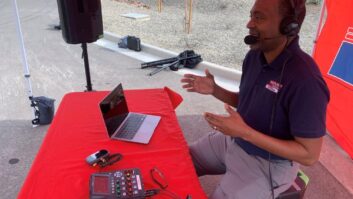The KGO 810 talk studio. Custom furniture by Omnirax. Cumulus Media Inc. is an American broadcasting company founded in 1996. Headquartered in Atlanta, it also owns Westwood One and reaches 245 million people weekly through its 567 stations in 120 cities.

The broadcasting company�s San Francisco cluster is the consolidation of some very well recognized brands: FM stations KFOG (104.5) and KSAN (107.7 The Bone), NASH FM 92.3; and on the AM band 680 KNBR (on-air since 1922), 1050 KTCT, KGO 810 News, and KSFO 560.
Local management, engineering, IT and program directors all contributed to the design, which was then drafted by Ohio architectural firm SHP Leading Design. Turner Construction of Atlanta began work on the project in October 2014; high-voltage/low-voltage engineering was installed by Cupertino Electric.
IP-based from end to end, the entire infrastructure is Axia Fusion consoles with Axia Powerstations.The first broadcast aired from the complex on Feb. 24, 2015.
KGO 810 Newsroom featuring Axia RAQ consoles.The KGO 810 Newsroom.


THE BUILDOUT
When Cumulus acquired Citadel Broadcasting Corp. in 2011, it shoehorned more stations into the existing Citadel building on San Francisco�s Hawthorne Street. Due to that lease�s impeding expiration, and the requirement for more space, another location was definitely needed: 750 Battery Street was selected.
KFOG�s air studio with Axia Fusion console and integrated VX controller. Two blocks from the bay (you can view it from the top floors), the structure commands the corner of Battery and Broadway in San Francisco�s North Beach area. Univision�s Bay Area radio cluster was in full operation there up until mid-2014; they had taken over the space from Clear Channel in 2001, which had occupied the building since 1990.

Though many decisions needed to be made during the construction phase � like that of not gutting the entire space and outfitting the newsroom in bulletproof glass � the total time from the first walkthrough to the first delivery of equipment was only four months.
�Having the opportunity to do a buildout of a complete cluster, this facility breaks many molds for the traditional radio studio buildout,� said Corporate Director of Engineering/Telecommunications Michael Gay, who served as senior systems and IT infrastructure design engineer and co-project manager for the new facilities. �The more we got into it, the more we realized we were actually building a data center that plays music on the air.
�All audio transport within the plant is facilitated via IP. All of this IP gear is connected to a central carrier class Cisco switch which handles thousands of multicast channels of uncompressed real time audio. All music is stored on hard drive and played out via IP �no sound cards in any machine. All mixing consoles are really just control surfaces for software mix engines performing the mixing of IP audio sources on an embedded hardware platform.
�Most audio cabling � analog or digital � never went more that10 feet within the plant before being converted to IP and the only audio ever leaving a studio was in the IP multicast realm. Welcome to the new world!�
PHYSICAL PLANT
A stack of DaySequerra monitoring receivers in the technical operations center. The complex contains a media lab; one large performance space with control room (which is equipped with a Midas 32 console); a newsroom and six dedicated production rooms.

The broadcast studios include:
KFOG � one control room
KSAN � one control room, one update studio/production room
NASH FM (a San Jose property run out of the cluster) � one control room
KNBR 680 � one control room, one talk studio, one update studio
1050 KTCT � one control room, one multi-use talk/production room
KGO 810 News � one control room, one talk studio, one update studio
KSFO 560 Talk � one control room, and one multi-use talk/production room
CONNECTIVITY�
Cumulus SFO technical operations center racks. Gay chose a Cisco Catalyst 4510 chassis-based router with line cards and supervisor cards. Though a single device, it is modular in nature, loaded with dual power supplies and gigabit PoE line cards. Given all sources and destinations the matrix is about 3000 x 3000. GPIO logic is wired in this manner as well, with pin-to-pin routing over the Axia Livewire network.

The news desks utilize Axia RAQ consoles with QOR.32 engines, each providing 32 I/O connections. RAQ has six rotary faders with OLED channel options displays, two stereo mixing buses and preview (cue) bus, a high-resolution OLED meter display with switchable VU/PPM ballistics, and monitor/headphone controls for auditioning program buses or the two assignable external monitor source selections.
Wheatstone M2 mic processors manage the Electro Voice RE27 dynamic mics and Genelec 8020B speakers keep the audio fidelity high. Avid HD Pro Tools is the primary DAW. CD, DAT, MiniDisc, analog open reel and cassette tape decks and turntables are all available. Much to my delight, I found a couple Eventide Ultra-Harmonizers in a control rack.
AUTOMATION
The performance space during construction. When I asked Gay what automation he had chosen for the complex, he replied �BSI�s OP-X, of course!� A little digging revealed why � BSI is a wholly owned subsidiary of Cumulus Media.

OP-X adheres to the Microsoft Windows Multimedia wave specification, so the look and feel of the software is very close to Microsoft Windows programs that are already familiar to operators and talent. Additionally, it works with standard PC parts and equipment.�
Among the numerous modules is the File Server which keeps track of audio files � their locations, their attributes, the stations they belong to and the data transfers to and from the audio servers in the system. An audio server is the actual player for the OP-X system with one located in every station. Each audio server connects to the singular file server which serves all the studios in the cluster. This server also controls satellite receivers and other outboard audio switching devices. The file server obtains the settings for each station, device configurations, satellite clocks, audio files and program logs.
The Studio Client permits users to operate OP-X from the studio as well as control room. As the most-used module in the system, all controls are operable from both touch-screen and mouse. From here, one can create hot keys to play sound effects, jingles, weather beds, etc., customize skins (the look of the interface to personal taste).
The Voice Track Editor allows not only the ability to pre-record voiceovers, but also access to the voice-track position in the fade-out of one tune and pre-programming the start of the next one. Even ducking volume is adjustable from this module. Remote Voice Tracking permits creation of voice tracks for a station in a remote location from your location (both equipped with OP-X) via an FTP client.
The Edit Mode module permits playlist editing while on the air.
Five additional modules � Clock Builder, Import-Merge, File Manager, Serial Device Server and Info Editor� � complete the package.
COMMUNICATIONS AND TELEPHONY
There is an Axia Intercom in each studio and at every one of the 22 newsroom positions. A Mitel 3300 phone system, XDS-PRO satellite receivers, Telos VX studio phone systems, Zephyr Xstreams (ISDN codecs), Zephyr Z/IP One IP codecs and Comrex Hotline (POTS codec) broadcast codecs round out the communication support.
Finally, the primary studio-to-transmitter systems are Harris Intraplex T1 shelves, with a secondary links composed of APT Horizon gear using an MPLS network.
TECHNICAL FURNITURE
107.7 The Bone on-air studio, featuring Omnirax custom furniture. One of the most important considerations of any installation, and one that gets little promotion, is the furniture that houses the equipment.�

Omnirax Furniture Co. of Sausalito, Calif., continued their relationship with Cumulus. According to Cumulus Senior Vice President Engineering and IT Gary Kline, Omnirax is Cumulus� �go to� studio furniture designer and fabricator. The two organizations have completed over 20 projects together in the past six years alone.
David Holland, partner and designer at Omnirax, described the project as �a great big dance� with Kline pulling the strings from above, Gay engineering the drawings, and Vice President of Engineering Martin Stabbert being on-point, orchestrating the physical installation. Regional Broadcast Engineering Director Yancy McNair contributed to the furniture design and integration as well.
Holland started with a 2D plan; once approved, went to 3D, and from there everything was computer modeled one-to-one. Every piece of furniture in every room is custom, and each a one of a kind � for all studios, the newsroom and the performance studio/control room. This required that each to be fully assembled, tested, set up, broken down, documented and then staged for shipping. Once delivered, McNair saw to the reassembly and installation.
750 Battery Street has a long and storied involvement with radio broadcasting. The first stations there were strictly analog; cart machines and analog consoles were the order of the day. Twenty-five years hence, the evolution in radio broadcast technology is clearly exemplified by Cumulus� new facility in San Francisco.










